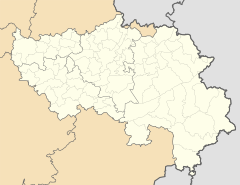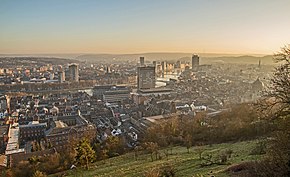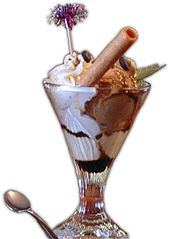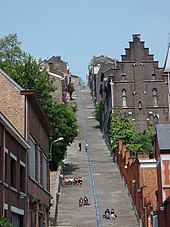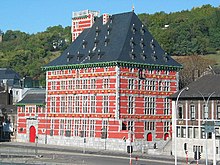Liege
| Liege | ||
|---|---|---|

|

|
|
|
|
||
| State : |
|
|
| Region : | Wallonia | |
| Province : | Liege | |
| District : | Liege | |
| Coordinates : | 50 ° 39 ′ N , 5 ° 34 ′ E | |
| Area : | 69.39 km² | |
| Resident: | 197,217 (Jan 1, 2020) | |
| Population density: | 2842 inhabitants per km² | |
| Post Code: | 4000 (Liège, Glain, Rocourt) 4020 (Liège, Bressoux, Jupille-sur-Meuse, Wandre) 4030 (Grivegnée) 4031 (Angleur) 4032 (Chênée) |
|
| Prefix: | 04 | |
| Mayor: | Willy Demeyer ( PS ) | |
Local government address : |
Hôtel de Ville Place du Marché 2 4000 Liège |
|
| Website: | www.liege.be | |
Liège ( French officially, until 1949 Liége , Walloon Lîdje , Dutch , Luxembourgish Léck , Ripuarian Lück ) is the second largest Walloon city, center of the largest Walloon agglomeration and the cultural center of the Walloon Region of Belgium . It is the capital of the Province of Liège and the seat of the Diocese of Liège . The city with 197,217 inhabitants (as of January 1, 2020) is located at the confluence of the Ourthe and Maas rivers, 25 km as the crow flies south of Maastricht (NL) and 39 km southwest of Aachen (D). The Liège Basin and its suburbs have a population of around 600,000.
Liège has a university , other colleges, a theater, an opera and other cultural institutions.
story
middle Ages
The name in Roman times was Leodicum or Vicus Leodicus . In 717 the city developed as a bishopric and was an important political and cultural center in the Middle Ages. At the end of the Middle Ages it belonged to the territory of the Liège Monastery .
The ruling prince-bishops of Liège mostly came from the nobility of the Holy Roman Empire . The power center of the bishopric of Liège was the cathedral chapter , also ruled by the nobles of the empire , one of the largest in Central Europe. Albrecht II of Cuyk granted the citizens of the city the first privileges in 1196/1198 . As in other spiritual territories of the empire, urban autonomy could only partially develop. The Hochstift never became part of the Spanish or Austrian Netherlands and existed until its dissolution after the occupation by the Napoleonic revolutionary troops (see also: Peace of Campo Formio ) .
18th century
In 1789, partly in connection with the French Revolution , the so-called Liège Revolution took place . It was directed against the absolutist rule of Prince-Bishop Caesar Constantin Franz von Hoensbroech and was suppressed by troops on behalf of the Holy Roman Empire in early 1791.
During the French Revolution, the Lambertus Cathedral was looted and burned down.
In 1795, Liège was occupied by French troops, assigned to the Département de l'Ourthe and part of the First French Republic . After the overthrow of Napoleon Bonaparte , it became the Kingdom of the United Netherlands in 1815 and became part of the independent Kingdom of Belgium in 1830 .
Liège is the cradle of the continental European coal and steel industry . As early as 1720, the first steam engine on the European mainland began operating in a coal mine near Liège.
industrialization
From here, industrialization spread across the entire continent from the beginning of the 19th century. In particular, the steel company Cockerill-Sambre had its headquarters near Liège.
From 1888 to 1892 Liège was protected by the construction of a fortification ring with 12 forts made of concrete . In 1901 the Limburg coal field was discovered. In 1905 Liège was the location of the great industrial exhibition Exposition universelle de 1905 . During this time the city was a stronghold of the labor movement and also of the Walloon movement , which pleaded for an autonomy of the southern, French-speaking part of the country.
At the end of 1908, members of the Liègois Automobile Club founded the Liège-Spa Aero Club.
World wars
In both the First and the Second World War Liege was hard fought because of its location on an important Maas transition. In August 1914, a few days after the start of the First World War, the fortress became the first target of the German advance through Belgium according to the Schlieffen Plan . While the citadel was taken by a coup on August 7th, the forts of the fortress ring , including Fort Loncin , held out for over a week.
During the Second World War, the city was again one of the first targets of the German advance during the western campaign in May 1940. The stroke-like conquest of the Eben-Emael fort by German paratroopers became known. From 1940 to 1944 the city was occupied by Wehrmacht troops and was a center of the Resistance .
post war period
Since industrialization , numerous people have immigrated from Flanders , Italy and, since 1945, also from North Africa , which is still reflected in the population structure of the city today. In the last few decades immigrants came from sub-Saharan African countries; Liège has become a multiethnic, multicultural city. Since the 1960s in particular, the cityscape has changed with the removal of old buildings.
With the decline of coal mining in the Liège Basin and the subsequent steel crisis , the region had to face the difficulties of structural change and was in financial distress. In the 1970s , among other things, the plan to build a subway had to be abandoned.
On December 13, 2011, a 33-year-old gunman killed six people and injured 124.
On May 29, 2018 attacked a recently released prisoners from the two police officers with knives, stole their handgun and shot her and a passer-by.
politics
coat of arms
Blazon : “In red a golden three-part column with a wider lower part on a pyramidal, flat three-tiered base, this set with three reclining lions, two at the side, looking outwards, one in front, facing, closed with a cross-studded peg in a conical casing, surrounded by the golden ones Serif capital letters "L" and "G". "
The column is the upper part of the Liège market fountain, called "peron" in Walloon (from old French perron , "big stone"), a former justice symbol on the Liège market and in other cities of the Liège Monastery.
Conseil Communal (local council)
Result of the local elections on October 14, 2012 (compared to the 2006 local elections):
| Political party | voices | Mandates | ||||
|---|---|---|---|---|---|---|
| number | % | +/- | number | +/- | ||
|
|
Parti socialiste (PS, social democratic) | 37,289 | 37.95 | −0.02 | 22nd | +1 |
|
|
Mouvement Réformateur (MR, liberal) | 20,819 | 21.19 | −4.88 | 11 | −3 |
|
|
Center Démocrate Humaniste (cdH, Christian Democratic) | 13,769 | 14.01 | −0.35 | 7th | - |
|
|
Ecolo (green) | 12,021 | 12.23 | +0.01 | 6th | - |
| Parti du Travail de Belgique (ptb +, Marxist) | 6,297 | 6.41 | - | 2 | +2 | |
| La Coopérative politique Verts et à Gauche (VEGA, green-left) | 3,534 | 3.60 | - | 1 | +1 | |
| Source: Official election results on elections2012.wallonie.be | ||||||
City structure
- Amercœur
- Burenville
- Center
- Coin
- Guillemins
- Laveu
- Longdoz
- North
- Outremeuse
- Saint-Laurent
- Sainte-Marguerite
- Sainte-Walburge
- Thier-à-Liège
- Vennes
training
Liège is home to the French-speaking University of Liège (founded in 1817) and the Haute École de la Province de Liège (HEPL), a university with predominantly economic, administrative and technical courses. In the artistic and musical field, there is an academy of fine arts ( Académie Royale des Beaux-Arts de Liège ), a music conservatory ( Conservatoire Royal de Liège ) and an ecclesiastical art college, École supérieure des arts Saint-Luc de Liège .
Culture
In Liège there is, among other things, La Boverie as a museum for modern and contemporary art, the Museum Grand Curtius , which brings together several exhibitions (including weapons and glasses), the Aquarium-Museum as a natural history museum specializing in fish, the archaeological Archéoforum, the house of Natural Science, the Metallurgy and Industry Museum , the City Palace Musée d'Ansembourg , the MADMUSEE - Museum of Differentiated Art, the Museum of Walloon Art, the Museum of Walloon Folklore, the Museum of Local Public Transport of the Liège Country, the Open-Air Museum on the Sart- Tilman, the Musée Grétry , the Musée Tchantchès with a collection of puppets by the sculptor and puppet maker Denis Bisscheroux and the treasury of the cathedral.
Liège is home to the Opéra Royal de Wallonie and a Royal Philharmonic.
As a culturally significant city in the greater Saar-Lor-Lux region , Liège took part in the 2007 program of the European Capital of Culture year .
The writer Georges Simenon comes from Liège .
Culinary specialties
- Liège waffles
- Liège meatballs - meatballs with sweet and sour sauce: Lapin sauce with Liège syrup
- Salade liégeoise - a special type of bean salad
- Liège syrup - strongly boiled down syrup made from pears and apples
- Jupiler brand beer
- Café Liégeois , which was known as Café Viennois until the First World War, is named after Liège .
Sports
Liège is known for the one-day race Liège – Bastogne – Liège . It is the oldest among the classics of cycling.
The first division football team Standard Liège and the former first division RFC Liège are also well known . In 2000, Liège was one of the venues for the European Football Championship .
business
Liège was once the center of heavy industry and was nicknamed la Cité ardente , “the glowing city” because of the numerous blast furnaces . Since the 1970s, the steel industry has largely disappeared from the region. Since then, the region has suffered from a permanently high level of unemployment (June 2011: 26.3%). Since then, the city has been trying to attract service companies . Weapons have been produced in Liège since the 16th century. The largest company to date is FN Herstal . The large brewery Piedbœuf , which is part of the Inbev brewery group and in which, among other things, the beer with the brand name Jupiler is brewed, is one of the numerous other industrial companies in Liège .
traffic
railroad
Liège is the main railway junction in eastern Belgium. The Liège S-Bahn lines run around the city . The main train stations in the city are mentioned below:
- Liège-Guillemins train station
Liège's new main train station, Liège-Guillemins , was built according to the plans of Santiago Calatrava , has an imposing roof and is technically adapted to the requirements of international high-speed trains. Trains run several times a day to Aachen and Cologne ( Thalys and ICE International ) as well as to Brussels and Paris (Thalys).
This station fulfills the function of the main station . Located outside the city center, this is where all the major railway lines from the vicinity of Liège meet. There are around 500 trains per day, including to Ostend via Brussels ; to Antwerp (via Hasselt , not via Brussels); Luxembourg ; Eupen ; Charleroi (to Paris ) and local trains to Jemelle .
- Liège-Carré stop
The Liège-Carré stop ( Liège-Jonfosse until 2018 ) is located near the city center on route 34 (Liège - Hasselt) between the Liège-Guillemins and Liège-Saint-Lambert stations.
- Liège-Saint-Lambert train station
The Liège-Saint-Lambert train station (until 2018 Liège-Palais ) is the train station in the city center of Liège, located under the Prince-Bishop's Palace on St. Lambert Square. The track systems are in a trough; In the reception building, tickets can be bought in small underground pavilions.
- Angleur train station
Angleur station is a suburban and branch station in the east of the city. This is where the railway lines to Aachen and Marloie branch out from Liège .
- Kinkempois formation station
The Kinkempois-Formation marshalling yard , located in the south of Liège on pure freight train routes, was at times one of the largest in Belgium. It was shut down in 2009 as a result of the extensive abandonment of local heavy industry and the general structural change in rail freight transport .
Public transport
The line traffic in Liège is handled by the TEC . There are bus lanes on some road axes. Since a metro was supposed to be built in Liège earlier, some buses run through tunnels.
After a tram operated in Liège from 1871 to 1967 , the high volume of traffic means that the tram will now be rebuilt. On February 10, 2017, Eurostat, the European supervisory body for accounting standards, approved the financing package for tram construction. Work began in mid-2019 and the opening is scheduled for October 2022. First of all, the Sclessin - Coronmeuse section is to be built, which will cover around 11 kilometers with 21 stations and cost around 325 million euros. In the new project, the tunnels built for a subway and the partially existing bus lanes are to be used.
shipping
The port of Liège is the third largest inland port in Europe, which also offers a connection to the port of Antwerp for smaller seagoing vessels thanks to the connection via the Albert Canal .
road
Liege is on the highways E 40 ( A3 ), E 313 ( A13 ), E 42 ( A15 ) and E 25 ( A25 and A26 tethered) to the European motorway network.
air traffic
The Liege Airport (Bierset) is of great importance for the distribution of goods to Belgium, Germany, northern France and the Netherlands. There has TNT Airways to be the world's largest road-air stroke; More than 80 cargo aircraft land every day and hundreds of trucks dock there. Passenger planes will also be handled at the new terminal.
sightseeing features

Churches
- Saint-Paul cathedral : Gothic, with an attached museum of the church treasures ( → location )
- Church Saint-Jacques : Late Gothic with rich interior ( → location )
- Church Saint-Barthélemy . Romanic with Baroque interior and baptismal font from the 12th century ( → location )
- Church Saint-Denis : roman; oldest church building, originally part of the city wall ( → location )
- Basilica Saint-Martin : Gothic ( → location )
- Church of the Holy Cross : Romanesque-Gothic church building, collegiate monastery and one of seven monastery chapters ( → location )
- the two large domed churches St. Vincent ( → Lage ) and Sacré-Cœur et Notre-Dame de Lourdes ( → Lage )
More Attractions
- Liège-Guillemins station with its large, curved roof in a cantilevered construction
- the prince-bishop's palace on Place Saint-Lambert, today provincial palace and court ( → location )
- the town hall (built 1714–1718 in the Baroque style) and the market square ( → Lage )
- Numerous museums, including:
- Grand Curtius museum complex, partly from the beginning of the 17th century ( → location )
- Liège Transport Museum
- the university building ( → location )
- the aquarium ( → location )
- Numerous magnificent buildings from the 18th century
- some partially listed Art Nouveau buildings . Examples: Hôtel Verlaine ( → Lage ), Boulevard de l'Est 16 ( → Lage ), a whole group of Art Nouveau buildings in the Rue du Vieux Mayeur ( → Lage ) and in the Rue Léon Mignon (also Séquence Nusbaum after the architect Joseph Nusbaum named; → location )
- In the Quartier Vennes between the Art Deco domed church of St. Vincent and the Rue de Paris there are a number of magnificent townhouses in a wide variety of architectural styles from the period between 1900 and 1930 ( → location ).
- Marché de la Batte : the market held every Sunday, stretches for several kilometers along the left Maaskaies
- Also worth seeing is the view over the city from the viewpoints at the former citadel ( → location and → location ), which can be seen among others. can be reached via the famous Montagne de Bueren ( → Lage ) staircase .
District
Due to its location in the narrow Meuse valley and the spoil heaps left by coal mining, many districts with a peculiar character have developed in Liège.
Coin
Cointe is located in the southwest of the city and west of the "Liège Guillemins" train station on a hill that is crossed by the E25, which serves as an urban motorway, in the "Tunel de la Cointe". The tunnel with a length of 1639 meters was completed in 2000 and runs up to 60 meters below the built-up area.
The district was once the hunting ground of the prince-bishops of Liège and was first mentioned in connection with the construction of the Saint-Maur chapel in 1673. From the Merovingians until the end of the 19th century, viticulture was practiced on the well exposed sites above the Val St. Benoit . Coal mining was another industry. The tunnels were all over the hill of Cointe; they are often rediscovered during collapses or construction work. The area was upgraded with the World Exhibition in 1905 , on the occasion of which 19 hectares of today's district were attached to the exhibition grounds and were used in particular for horticultural and sporting purposes. Before it was incorporated into the municipality of Liège in 1977, Cointe belonged to the neighboring municipality of Ougrée.
Cointe is home to a so-called "private park", which includes the gardens of the villas that were built around the turn of the century and the steep flank of the Meuse valley to the south. The construction and development of the "private park" began with the sale of land from 1880 by the Hauzeur family. Strict adherence to certain rules, such as compliance with minimum distances and use as living space, was ensured. The resulting villas reflect a variety of recent architectural trends, such as Néotraditionel , Art nouveau , Moderniste , Néomosan and so on. Worth mentioning is the “L'Aube” house built in Liège Art nouveau in 1903 by the architect Gustave Serrurier-Bovy (1858–1910). The large contiguous green area of the “private park” has a recognized, important ecological function for the preservation of biodiversity and as a migration corridor for fauna and flora. For example, the endangered stag beetle was found here.
At the private park are also:
- The "Sacré Coeur et Notre Dame de Lourdes" basilica
- The “Mémorial interallié”, built in 1928 and not completed; it was created as a memorial to the Belgian resistance against the invading enemy troops in World War I, which had started in Liège. The 75 m high tower, which is visible from afar, offers a particularly good view of the city.
- The neo-Gothic former observatory of the Liège University from 1881 (very much in need of renovation).
To the north of the “Place du Batty”, which is now the commercial center of the district, is the Plaine de Cointe , an extensive park with a public sports field, tennis courts and a lookout point that allows a view over the city center. To the west of it there is a residential area characterized by partly still typical brick houses, which is also known as the Quartier des Bruyères .
Le Carré
The center of Liège nightlife is located between Rue Pont d'Avroy , Rue de la Casquette and St. Adalbert and Boulevard de la Sauvenière . Above all, the students from the campus in Sart-Tilman populate the countless bars and cafés in the narrow, right-angled streets.
Outremeuse
Outremeuse ("across the Meuse") is a district of Liège. Every August there is a Liège city festival of the same name. The quarter was originally characterized by the middle class with numerous small craft businesses. Most of the residents lived in modest circumstances. The structure and atmosphere of the neighborhood at the beginning of the twentieth century are well represented in the autobiographical novel "Pedigree" by Georges Simenon , who grew up in Outremeuse.
- Other districts worth mentioning are
- Publémont, Sainte Marguerite and Sart Tilman.
Town twinning
|
|
Euregio Meuse-Rhine
-
 Aachen ( Germany ) (1955)
Aachen ( Germany ) (1955) -
 Maastricht ( Netherlands ) (1955)
Maastricht ( Netherlands ) (1955) -
 Heerlen ( Netherlands ) (1955)
Heerlen ( Netherlands ) (1955) -
 Hasselt ( Belgium ) (1955)
Hasselt ( Belgium ) (1955)
Personalities
literature
- Baedeker "Belgium". Ostfildern: Verlag Karl Baedeker 1998 (3), ISBN 3-87504-417-7 , pp. 285-297.
- Liège - On the way in the shining city on the Meuse, author: Rolf Minderjahn, Verlag, GEV (Grenz-Echo-Verlag), ISBN 978-3-86712-062-3 .
- 111 must-see places in Liège by Alexander Barth, with photographs by Jenny Roder, Cologne: Emons Verlag 2016, ISBN 978-3-95451-925-5 .
Web links
Individual evidence
- ^ Joan Blaeu : Novum Ac Magnum Theatrum Urbium Belgicae. Amsterdam, 1649.
-
^ For contemporary engravings by Jean-Noël Chevron, seeCommons : Cathédrale Notre-Dame-et-Saint-Lambert de Liège on Commons - Collection of images, videos and audio files.
- ↑ European Route of Industrial Culture: Industrial History of Belgium ( Memento des Originals from July 17, 2007 in the Internet Archive ) Info: The archive link has been inserted automatically and has not yet been checked. Please check the original and archive link according to the instructions and then remove this notice.
- ↑ Flight edition January 2, 1909, p. 4; www.spa-aviation.be
- ↑ Three dead in a hostage-taking in Belgium
- ↑ Olaf Münichsdorfer: Bright spots for Liège. d'Land November 13, 2009. p. 27.
- ↑ Homepage of the alliance for the reintroduction of the tram in Liège (in French)
- ↑ Le Port autonome de Liège , website of the port, accessed on 25 February 2015
